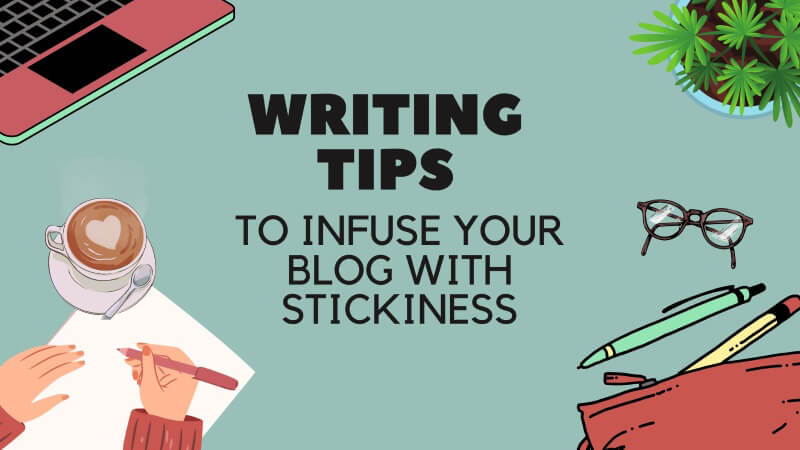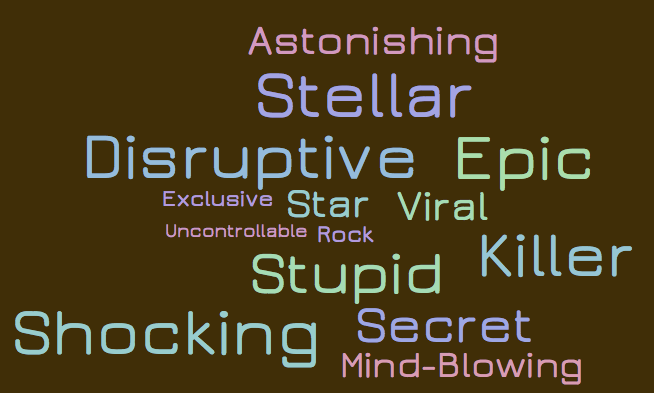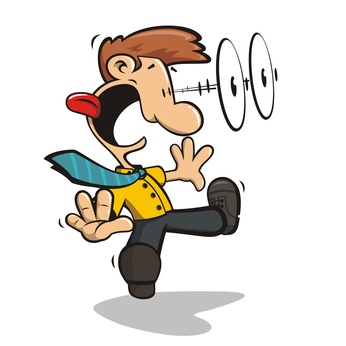Writing Tips to Infuse Your Blog With Stickiness

10 seconds. It isn’t enough time to publish a Tweet or respond to a Facebook comment, but it’s one of the most important metrics online. According to Microsoft research, that’s all the time you have to impress visitors to your web pages.
The average length of a website visit is between 10-20 seconds, but most decisions about the value of a page’s content are made in around 8 seconds. As Marketer John G. Olsen points out, there’s certainly no time to impress anyone with the main body content of your blog articles. You’ve got to capture interest with a dazzling title, intriguing introductory paragraph, and achieve stickiness with a concluding call-to-action.
Regardless of how well you’ve adopted writing tips for exceptional blog posts, you’ve got to create content that makes a powerful first impression. We’ve compiled expert insight on how to move your readers to action, with writing tips for each of the three most visible blog page components:
Truly Impressive Blog Titles
For visitors to your blog, Olsen estimates that about 3 out of the first 8 seconds on the page will be spent evaluating the blog title. If that’s not overwhelming enough, consider the fact that titles are arguably the only thing that matters on social media. Consider the following factors which illustrate just how much weight blog titles carry online:
- It’s All People See on Twitter: While some social media ninjas may Tweet quotes or stats from an article, the majority of content sharing consists of a blog title and a link. For social media users scrolling through a busy social media feed, a title is your only chance to capture attention.
- People Don’t Always Read Articles: Social Media Scientist Dan Zarrella ran analysis on the social sharing of over 2.7 million blogs, which revealed a pretty shocking truth. 16.12% of these blogs had more social shares than page views, which means people don’t always read before they Tweet or ReTweet. Titles trump writing tips for social exposure.
- Titles Dominate SEO: While the exact factors which affect your content’s final ranking in search results are a closely-guarded secret, SEO experts believe that writing tips for a title carry more weight than any other text on page.
Never underestimate the power of word choice among writing tips for blog titles. Your readers probably don’t want to engage with a piece of content which promises “Good Ideas for Content Marketing.” There’s an abundance of “good” content online, which is why it’s critical to leverage powerful words which achieve a balance between disruption and hyperbole. SEO expert Dan Shure has found that the most effective words aren’t just strong, they have the power to evoke emotion in a reader.
Infuse your blog titles with emotion-inspiring adjectives, which could include the following options:

- Astonishing
- Stupid
- Viral
- Epic
- Stellar
- Remarkable
- Uncontrollable
- Shocking
- Ground-Breaking
- Exclusive
- Life-Changing
- Secret
- Killer
- Rock Star
- Mind-Blowing
- Disruptive
Taking the time to find the right adjectives to lend some extra power to your blog title can be the difference between content which leaves little impression, and content that’s read and shared. If you don’t adopt any other writing tips this week, consider integrating several of the following proven headline formulas into your content marketing strategy:
1. The Secret of [Blank]
Who doesn’t want to be let in on a secret? This title leverages the law of attraction, and makes readers feel like they’re gaining exclusive access to something.
Examples:
- 25 Secrets of Great Copywriting from Classic Literary Masters
- 11 Blogging Experts’ Secrets on How to Get More Subscribers
2. Little Known Ways to [Blank]
People don’t want to read general content. They want articles which offer value they can’t find at your competitors’ websites.
Examples:
- 20 Exclusive Copywriting Tips Even Gurus Will Be Surprised to Know
- 17 Lesser Known Ways to Persuade People
3. The Shocking Truth About [Blank]
Outstanding blog titles manage to disrupt a website visitor enough to keep them reading. A title which promises surprise or shock-value is among the most powerful writing tips.
Examples:
- 19 Surprising Call Marketing Stats You Can’t Ignore
- 101 Shocking Helpful Quotes for Online Marketing
4. New Research on [Blank] Reveals
Who wants to read an article about old news, like MySpace or the 2012 Presidential Election? Almost no one. Prominently displaying new information can convey significant value.
Examples:
- How to Nimbly Adjust Your Content Strategy to Google’s Upcoming Changes
- Top Marketing Events and Conferences to Attend in 2024
5. How to Avoid [Something Horrible]
Studies at the intersection of marketing and psychology have discovered that the negativity bias has a powerful effect on human behavior. Mapping your blog titles to your buyer personas’ pain points can create a sense of urgency in engaging with your content.
Examples:
- 23 Terrible Blog Marketing Tips You Should Ignore
- How to Write a Terrible, Horrible, No-Good, Very Bad Blog Post
6. How to Easily Solve [Problem]
People love easy solutions. If your content reveals simple explanations for common problems among your buyer personas, emphasize this factor.
Examples:
- Starting a Blog: 20 Attainable Steps to Epic Success
- How to Write a Bare-Bones Content Strategy for Small Business
While these writing tips for headlines don’t encompass every outline for an effective page description, leveraging the power to attract and engage by relaying urgency, relevance or ease can significantly increase your social shares and your ability to engage visitors to your website.
Introductory Paragraphs with Sticking Power
Once your blog title’s passed the litmus test of page visitors, they’ll likely spend a few moments scanning your introductory paragraph to further evaluate the potential of your content marketing.
If you’ve nailed your title, your first sentences are the second most-important place to infuse your copy with the world’s sharpest writing tips. Olsen performed a study on Reader’s Digest, a print publication which has prevailed in part due to its stellar writing structure. His research on their introductory paragraph formulas uncovered the following common factors:
- They’re Jam-Packed with Hard-Hitting Facts
- They Convey the Value Within the Article
- They’re Specific, Not General or Broad
- They’re Straight-to-the-Point, Not Filled with Extraneous Words
- They Inspire Curiosity and Awe in Readers
The following writing tips for blog introductions will allow you to integrate each of these time-tested formulas into your first paragraphs:
1. The Power Stat
By 2023, an estimated 88% of companies will have a content marketing strategy in place.
88% percent? That’s a pretty significant majority. By unleashing a little-known, powerful, and surprising statistic straight out of the gate, you can immediately communicate your expertise, and convey the value within your content. There’s a time and place for well-known and unsurprising statistics, but it isn’t in the first sentences of your blog articles. Use the very best available to immediately capture attention.
2. The Value-Teaser
As a small business owner, I struggle to find the time to create effective content.
There’s a trick to using your introductory paragraph to convey value. The first sentences aren’t the time or place to be self-promotional. You’ve got to immediately establish that you know something about your buyer personas’ pain points or priorities. Relevance matters, which is why one of the most effective ways to convey value is through showing, not telling. Communicate in stories, anecdotes, or even jokes.
3. The Perfectly-Aimed Arrow
The vast majority of software-as-a-service companies fail to succeed.
While it’s true that many small businesses fail across all industries, that fact wouldn’t make for as compelling of an introduction. Using your first sentences to narrow down your focus and audience will allow your ideal readers to say “Hey! That’s me!” and excitedly continue reading. Relay your optimal audience and provide targeted value from your first sentences onward.
4. The Pithy Statement
Content marketing is big business.
Could you fluff up this sentence with lots of extra words, like “The current state of blog and eBook marketing is a significant player on the marketing scene?” You certainly could, but you might cause your readers to hit the back button. Aiming for conciseness is among the smarter writing tips, and getting straight to the point in the first paragraph will let your readers know that you value their time.
5. The Shocker
Did you know most blogs receive only 650 page views each month?

Readers don’t engage with content which makes them yawn. By shocking and distracting your website visitors from the first few sentences, you can differentiate from your competition and communicate that your company has something different to offer. No writing tips worth their salt will recommend boring first sentences.
Once you’ve accomplished the task of writing an engaging introductory paragraph, you’ve essentially won one of the toughest battles content marketers face online: engaging readers and preventing them from hitting the dreaded back-button. Don’t use up all your favorite writing tips here, though – powerful call-to-actions matter, and it’s important to inspire your readers to action.
Motivating Call-to-Actions
When a reader has absorbed your blog article, do you want them to leave your website feeling satisfied? Absolutely not. If you’re among the majority of companies blogging for leads, customers or social media exposure, it’s crucial to inspire your readers to action. Including a call-to-action at the bottom of each of your blog articles can increase your chances of gaining comments, shares, or contact information from your first-time website visitors.
Simply defined, a call-to-action (CTA) is a graphic or section of text which acts as an impetus for your reader to take a clearly-defined action. This could include subscribing to your blog, Tweeting your post, leaving a comment, or downloading your latest eBook on writing tips. Content Marketing Insitute’s Mark Sherbin has defined three primary categories of CTAs:
1. Nurturing the Relationship
To capture the attention of a first-time visitor who might not be ready to become a formal lead or customer, it’s essential to extend an invitation to become a member of your community. This could include a request to leave a comment, an invitation to your upcoming TweetChat, or other no-obligation resources.
2. Capturing Lead Interest
For website visitors who are ready to begin considering your company, include CTAs which offer an opportunity to become a lead. This will primarily consist of links to landing pages on your website, for free eBooks, webinars, or consultations.
3. Soliciting a Sale
To provide ample opportunity for website visitors who are ready to become a customer to make a purchase, don’t be shy about advertising your deals, specials and other exclusive offers. Ideas could range from a product comparison tip sheet to a discount code offered only to your blog readers.
Writing tips for your CTAs will only be effective if you manage to match your offers and invitations to your readership and unique sales cycle. Articles which primarily focus on general questions and other introductory subjects should be combined with relationship-nurturing CTAs. Content targeted towards existing leads and customers should be combined with a CTA that includes an invitation to purchase.
Your CTAs don’t need to consist of complex design work. Text CTAs can be powerfully effective motivators, too – and there’s a good chance you’ve encountered something which resembles on the following on at least one blog recently:
Which types of writing tips are you currently using in your marketing? Share your thoughts and experience in the comments below!
Regardless of whether you decide to design a complex CTA button in Adobe InDesign or rely on simple text, it’s important to consider the following writing tips to effectively inspire your readers to action:
- Be Concise: CTAs can be humorous or serious, and vary in any number of other ways, but they need to be clear. There should be no question about what action a visitor should take, regardless of whether you’re asking for a Facebook like or sale. Get the point across, and be sure there’s no room for confusion.
- Convey Value: What’s in it for me? People are busy, and they’ll probably disregard your CTA unless it explains how it will benefit them. Whether you’re offering an opportunity to be heard in your comments section, or the world’s coolest eBook on how to outsource copywriting, be clear about what they’ll receive in return.
- Distinguish Your CTA from Text: To accommodate blog readers who scan or skim your content instead of reading every word in-depth, create a clear barrier between the body of your content and your CTA. If you’re using a text invitation, italicize or bold the words. For designed CTAs, create an image that clearly stands out from the rest of your page.
Even marketers who know all the writing tips can find themselves creating content which gets ignored. By mastering all three of the most important blog page components, you can effectively capture attention, win the 10-second test, and gain the attention your company deserves.
What writing tips do you leverage to create engaging content that inspires your website visitors to action?

Comment (1)
To the writtent.com webmaster, Thanks for the well-presented post!